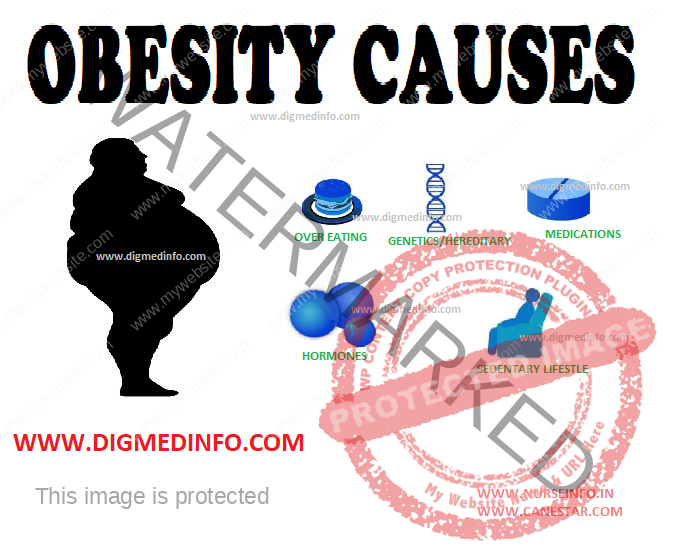OBESITY – CAUSES AND PATHOLOGY
ETIOLOGY
1. Excessive consumption of food accounts for the vast majority. Training in early childhood and social factors influence eating habits. Both in anxiety and depression, excessive eating may be resorted to. It is not uncommon to develop obesity after recent bereavement or change of job. An increase of 0.5% in food consumption above the optimal caloric intake can lead to an annual rise in weight of 1 kg. Pregnancy and contraceptive pills tend to predispose to obesity. Persons show strong genetic predisposition to obesity and the amount of food leading to obesity varies widely between subjects. Therefore prescription of dietary management has also to be individualized.
2. Hormonal and other factors Obesity may be part of the clinical pictures of well-known endocrine disorders such as type 2 diabetes, hypothyroidism, Cushing’s syndrome, gigantism, acromegaly, insulinomas and others. In addition several hormones regulate appetite and modulate intake of food and fat accumulation. Insulin and cholecystokinin acting on the central nervous system retard the appetite regulating mechanism.
3. Genetic factors do play a role. Metabolically, some individuals are more efficient in conserving energy and thus they put on fat, while others require more energy for the same amount of work performed.
Moreover, obesity may run in families. The role of leptins There is strong evidence that body fat is biologically regulated. Most cases of obesity probably reflect a multigenetic predisposition for excess intake of food, low level of physical activity and accumulation of excess amounts of fat. Leptin encoded by the Lcp gene is a cytokine-like molecule synthesized and secreted by adipose tissue in proportion to adipose tissue mass. It has several biological effects, an important one being reduction of food intake. Leptin deficiency leads to hyperphagia, obesity, and several endocrine abnormalities such as infertility, diabetes, reduction in metabolism, impairment of somatic growth and elevated levels of glucocorticoids. Leptin deficiency and resistance to leptin may be genetically determined.
Several other hormones also influence food intake and body weight. A gut hormone fragment peptide-Y3-36 (pYY) reduces appetite by acting on the appetite centers in the hypothalamus. Ghrelin is a hormone primarily secreted by the stomach and duodenum. Plasma ghrelin levels are higher before meals and their levels fall after meals. Ghrelin has been implicated in causing hunger at meal times and also the long-term maintenance of body weight.
Drugs
Several drugs lead to weight gain. Prominent among them are antipsychotics, anti depressants anticonvulsants, oral contraceptives, progestogens, oral hypoglycemic agents, insulin, corticosteroids, beta adrenergic blockers, antihistamines and others.
Childhood obesity occurring below 3 years of age without parental obesity is not a risk factor for obesity in adulthood. On the other hand obesity which persists beyond 6 years of age it is a predictor of adult obesity irrespective of the parental status. Presence of obesity in the parents doubles the risk.
4. Physical activity which causes loss of calories is closely related to obesity. Modern amenities such as automobiles and lifts which tend to minimize day-today physical exertion favour the development of obesity. Obesity is more evident when there is a sudden cessation of physical activity. Eating habits are also influenced by physical work. Moderate work is associated with optimal food intake whereas both physical inactivity and overexertion lead to overeating.
5. Alcohol being a good source of non-diet calories tends to aggravate obesity in the mild and moderate alcoholics. Cessation of smoking leads to recovery of appetite and gain in weight.
PATHOLOGY
Obese subjects have increase of both fat and non-fat mass. In obesity developing from childhood, there is probably increase in the number of fat cells and a generalized increase in adipose tissue.
In others there is hypertrophy of the fat cells. Distribution of obesity may be android (abdomen and shoulder predominantly) or gynoid (buttocks, thighs, breasts, arm and face predominantly. Obesity leads to impairment of carbohydrate tolerance, elevation of cholesterol level in blood, and mild elevation of blood pressure. It predisposes to premature atherosclerosis. Obesity is associated with an absolute increase in energy expenditure, lower respiratory quotient and insulinresistance. Though obese subjects have to spend more energy for the same amount of work done by their normal counterparts, they tend to restrict their physical activity further and accumulate more fat.


